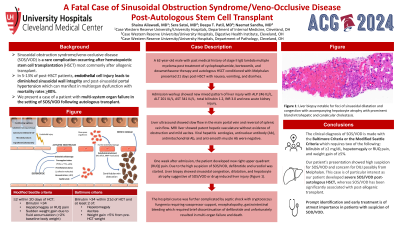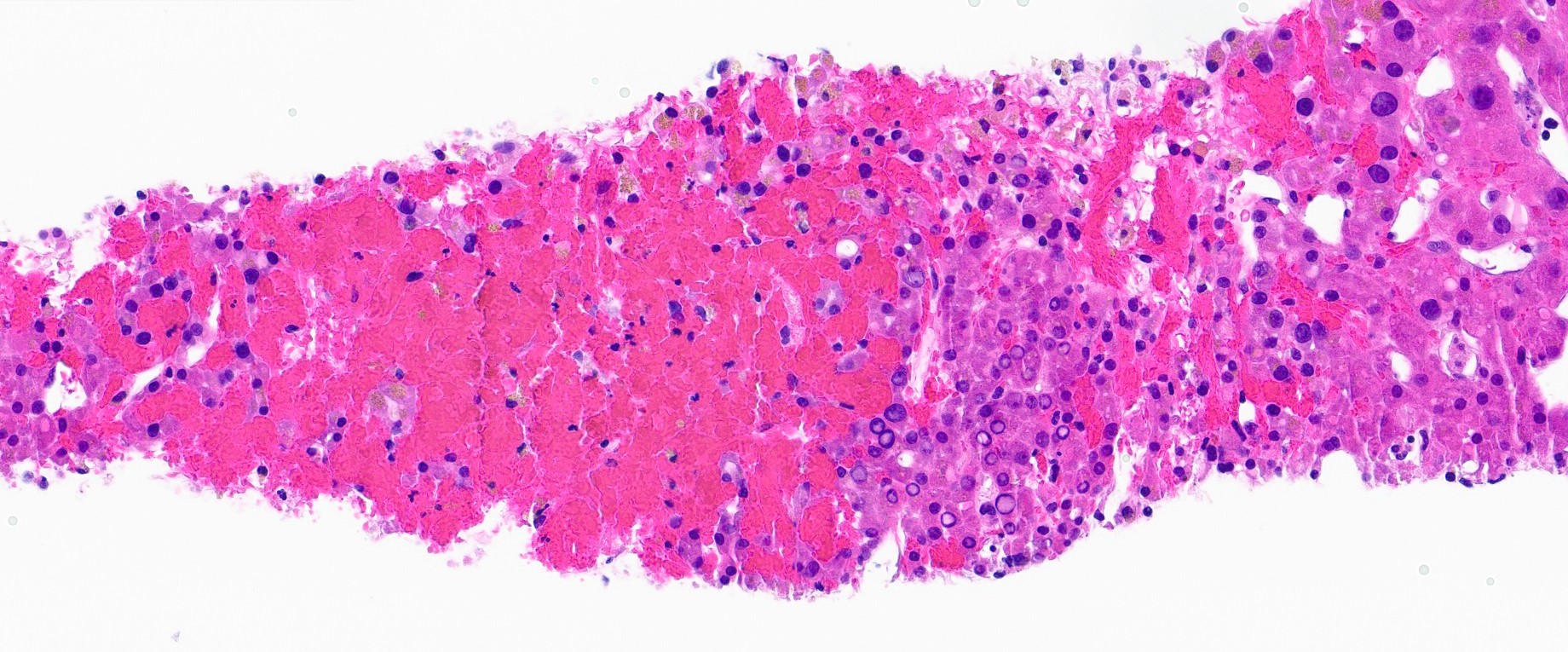Monday Poster Session
Category: Liver
P3070 - A Fatal Case of Sinusoidal Obstruction Syndrome/Veno-Occlusive Disease Post-Autologous Stem Cell Transplant
Monday, October 28, 2024
10:30 AM - 4:00 PM ET
Location: Exhibit Hall E

Has Audio

Shaina Ailawadi, MD
University Hospitals Cleveland Medical Center, Case Western Reserve University
Cleveland, OH
Presenting Author(s)
Shaina Ailawadi, MD, Sera Satoi, MD, Deepa T. Patil, MD, Naemat Sandhu, MD
University Hospitals Cleveland Medical Center, Case Western Reserve University, Cleveland, OH
Introduction: Sinusoidal obstruction syndrome/veno-occlusive disease (SOS/VOD) is a rare complication occurring after hematopoietic stem cell transplantation (HSCT) most commonly after allogenic transplant. In 5-13% of post-HSCT patients, endothelial cell injury leads to diminished sinusoidal wall integrity and post-sinusoidal portal hypertension which can manifest in multiorgan dysfunction with mortality rates >80%. We present a case of a patient with multi-system organ failure in the setting of SOS/VOD following autologous transplant.
Case Description/Methods: A 62-year-old male with past medical history of stage II IgG lambda multiple myeloma post treatment of cyclophosphamide, bortezomib, and dexamethasone therapy and autologous HSCT conditioned with Melphalan presented 21 days post-HSCT with nausea, vomiting, and diarrhea. Admission workup showed new mixed pattern of liver injury with ALP 246 IU/L, ALT 201 IU/L, AST 341 IU/L, total bilirubin 1.2, INR 3.0 and new acute kidney injury. Liver ultrasound showed slow flow in the main portal vein and reversal of splenic vein flow. MRI liver showed patent hepatic vasculature without evidence of obstruction and mild ascites. Viral hepatitis serologies, antinuclear antibody (Ab), antimitochondrial Ab, and anti-smooth muscle Ab were negative. One week after admission, the patient developed new right upper quadrant (RUQ) pain. Due to the high suspicion of SOS/VOD, defibrotide and ursodiol was started. Liver biopsy showed sinusoidal congestion, dilatation, and hepatocyte atrophy suggestive of SOS/VOD or drug-induced liver injury (Figure 1). The hospital course was further complicated by septic shock with cryptococcus fungemia requiring vasopressor support, encephalopathy, gastrointestinal bleeding which required brief discontinuation of defibrotide and unfortunately resulted in multi-organ failure and death.
Discussion: The clinical diagnosis of SOS/VOD is made with the Baltimore Criteria or the Modified Seattle Criteria which requires two of the following: bilirubin of ≥2 mg/dL, hepatomegaly or RUQ pain, and weight gain of ≥5%. Our patient’s presentation showed high suspicion for SOS/VOD and concern for DILI possibly from Melphalan. This case is of particular interest as our patient developed severe SOS/VOD post-autologous HSCT, whereas SOS/VOD has been significantly associated with post-allogenic transplant. Prompt identification and early treatment is of utmost importance in patients with suspicion of SOD/VOD.

Disclosures:
Shaina Ailawadi, MD, Sera Satoi, MD, Deepa T. Patil, MD, Naemat Sandhu, MD. P3070 - A Fatal Case of Sinusoidal Obstruction Syndrome/Veno-Occlusive Disease Post-Autologous Stem Cell Transplant, ACG 2024 Annual Scientific Meeting Abstracts. Philadelphia, PA: American College of Gastroenterology.
University Hospitals Cleveland Medical Center, Case Western Reserve University, Cleveland, OH
Introduction: Sinusoidal obstruction syndrome/veno-occlusive disease (SOS/VOD) is a rare complication occurring after hematopoietic stem cell transplantation (HSCT) most commonly after allogenic transplant. In 5-13% of post-HSCT patients, endothelial cell injury leads to diminished sinusoidal wall integrity and post-sinusoidal portal hypertension which can manifest in multiorgan dysfunction with mortality rates >80%. We present a case of a patient with multi-system organ failure in the setting of SOS/VOD following autologous transplant.
Case Description/Methods: A 62-year-old male with past medical history of stage II IgG lambda multiple myeloma post treatment of cyclophosphamide, bortezomib, and dexamethasone therapy and autologous HSCT conditioned with Melphalan presented 21 days post-HSCT with nausea, vomiting, and diarrhea. Admission workup showed new mixed pattern of liver injury with ALP 246 IU/L, ALT 201 IU/L, AST 341 IU/L, total bilirubin 1.2, INR 3.0 and new acute kidney injury. Liver ultrasound showed slow flow in the main portal vein and reversal of splenic vein flow. MRI liver showed patent hepatic vasculature without evidence of obstruction and mild ascites. Viral hepatitis serologies, antinuclear antibody (Ab), antimitochondrial Ab, and anti-smooth muscle Ab were negative. One week after admission, the patient developed new right upper quadrant (RUQ) pain. Due to the high suspicion of SOS/VOD, defibrotide and ursodiol was started. Liver biopsy showed sinusoidal congestion, dilatation, and hepatocyte atrophy suggestive of SOS/VOD or drug-induced liver injury (Figure 1). The hospital course was further complicated by septic shock with cryptococcus fungemia requiring vasopressor support, encephalopathy, gastrointestinal bleeding which required brief discontinuation of defibrotide and unfortunately resulted in multi-organ failure and death.
Discussion: The clinical diagnosis of SOS/VOD is made with the Baltimore Criteria or the Modified Seattle Criteria which requires two of the following: bilirubin of ≥2 mg/dL, hepatomegaly or RUQ pain, and weight gain of ≥5%. Our patient’s presentation showed high suspicion for SOS/VOD and concern for DILI possibly from Melphalan. This case is of particular interest as our patient developed severe SOS/VOD post-autologous HSCT, whereas SOS/VOD has been significantly associated with post-allogenic transplant. Prompt identification and early treatment is of utmost importance in patients with suspicion of SOD/VOD.

Figure: Liver biopsy notable for foci of sinusoidal dilatation and congestion with accompanying hepatocyte atrophy with prominent bland intrahepatic and canalicular cholestasis.
Disclosures:
Shaina Ailawadi indicated no relevant financial relationships.
Sera Satoi indicated no relevant financial relationships.
Deepa T. Patil indicated no relevant financial relationships.
Naemat Sandhu indicated no relevant financial relationships.
Shaina Ailawadi, MD, Sera Satoi, MD, Deepa T. Patil, MD, Naemat Sandhu, MD. P3070 - A Fatal Case of Sinusoidal Obstruction Syndrome/Veno-Occlusive Disease Post-Autologous Stem Cell Transplant, ACG 2024 Annual Scientific Meeting Abstracts. Philadelphia, PA: American College of Gastroenterology.

